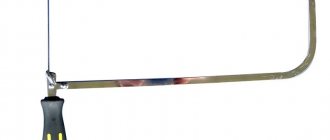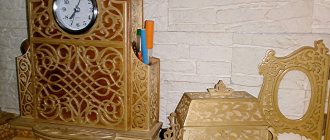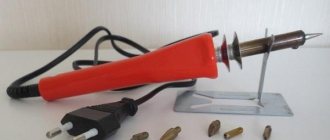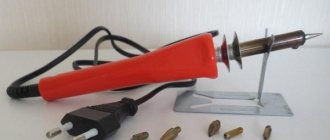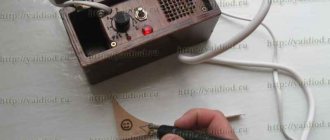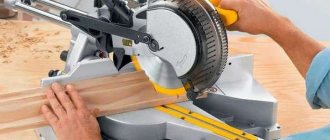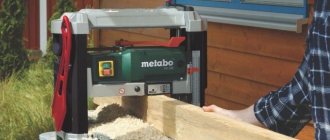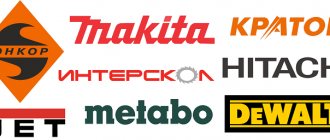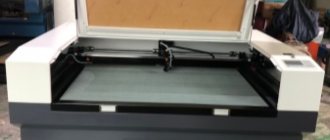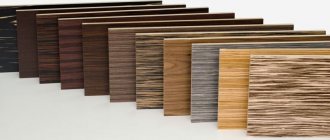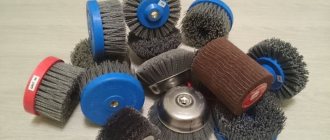It doesn’t matter whether you are making furniture or building a house, you need even and smooth boards - without them you can’t put together a cabinet or arrange a bathhouse. But not everyone can plan planing workpieces by hand, because this is a very dreary, difficult task, which also requires considerable precision and skill. A planer-thicknessing machine is designed to save the carpenter from this problem. Now we will tell you how to choose a planer-thicknesser machine and bring to your attention the Top 5 machines for wood processing from different manufacturers.
Design
The design of the machine in question includes the following parts:
- The engine runs on 220 Volts. An electric motor creates and transmits “torque” to the planing shaft with knives.
- A work table consisting of front and rear plates (made of cast iron and having special stiffening ribs, which ensure the stability of the working surface). The edges of the tiles are provided with special stainless steel overlays that protect the working surface from mechanical damage. The back plate is installed at the same level as the cutting blades. The front plate is located 2 mm lower than the rear one. The distance between them varies, which depends on what layer of material needs to be removed from the workpiece being processed.
- Bed, which is made of very durable alloys. This element supports the entire mass of the machine, and must also withstand the forces that the operator applies to pressing the workpiece. It also contains shafts with knives, guide parts and other fasteners.
- Planer shaft installed between front and back tiles. Blades of equal thickness, made of high-speed tool steel, are attached to this shaft. In the case when it is necessary to process hard wood material on a machine, the shaft must be additionally equipped with carbide tips.
- Guide - this element is a unit that is responsible for moving the moving parts of the equipment and the workpiece itself. The guide is attached to the frame by bolted connections and can move in a transverse direction.
- The circular fence is placed on the front tile and should fit snugly against the guide. This guard is made of sheet metal and provides protection for the knife shaft.
IMPORTANT! As a rule, jointing equipment can process parts with a length of 1 to 1.5 meters. Parts with a longer length are inconvenient to fix on the working surface of the table; they can become deformed, and this can also significantly reduce the accuracy of the cut and generally cause general inconvenience in work. But processing parts less than 1 m in length is generally dangerous.
Operating principle
The complete operating procedure of the equipment consists of the following steps:
- The back tile remains stationary throughout the entire production process. The location of the front tile is adjusted by the operator to the required height.
- After turning on the machine, the electric motor transmits speed to the knife shaft, as a result of which the cutting parts begin to rotate.
- The wooden blank is applied to the guide element (ruler) with both hands and directed to the cutters (knives). If the machine belongs to budget models, then feeding on it is carried out only manually, and this is dangerous. However, most modern machines are already equipped with an automatic feeder, which increases the speed of delivery of parts and ensures the overall safety of the production process.
- When the workpiece falls under the knives, they remove a layer thickness determined by the operator from the wood, thereby eliminating unevenness and creating a clean and flat base surface. The execution speed will directly depend on the planing technology. Most jointer machines can only finish one surface at a time, but there are already jointers available that can handle two sides at the same time.
If, upon completion of processing, small irregularities or fibers form on the surface, this indicates that the knife blades need to be sharpened again. If the unevenness is large, the distance between the tiles and the planing shaft must be properly adjusted.
DeWalt 733 – 52243₽
The manufacturer developed this DeWalt 733 model, designed for professional use, specifically for sale on the foreign market (American versions, marked “735”, have 3 knives on the working shaft and are powered from a 120-volt network).
And each implemented development definitely influenced the overall impression of practitioners. Rigid locking of the planing block position prevents any movement.
Including under the influence of an uneven surface of the workpiece. Fine adjustment and planing depth limiter ensure perfect calibration of lumber. The automatic circuit breaker stops the supply of electricity to the engine at the slightest increase in line voltage. The reinforced frame, cast bed and securely fixed additional tables allow you to avoid defects when working with long items. Main technical characteristics of DeWalt 733
| Characteristics | Values |
| power, kWt | 1.8 |
| Shaft rotation speed, rpm | 10000 |
| Automatic feed speed of workpiece, m/min | 8 |
| Planing depth (maximum / working), mm | 2 / 1 |
| Limit dimensions of the workpiece (H-height / B-width), mm | H-152, B-317 |
| Thicknessing table length, mm | 520 |
| Design features | Guide posts pass through each corner of the working block, fixing the planing shaft |
| Add. equipment | A set of keys, a chip guard, an adapter for connecting a vacuum cleaner |
| Weight, kg | 33.6 |
| Development/production | USA/USA |
| Cost, rub. | 52243 |
Watch video review of DeWalt 733:
Scope of application and advantageous features
Joining equipment is used to carry out the following production operations:
- Leveling surfaces on large wooden blocks;
- Rough trimming of workpiece planes;
- Angular grooving;
- Removing edges.
Unlike other automatic carpentry tools, jointers have the following advantages:
- It is possible to plan both large and small bars on them;
- They have a high quality cut;
- They have the ability to process the edges and surfaces of wooden parts in curved directions;
- If you equip the equipment with additional attachments, it can be used for cutting bars;
- They have a current price (starts from 10-14 thousand rubles).
Typically, jointers are used in the woodworking segment of the industry, as well as in construction and carpentry. Small models can also be found in home workshops.
Why do you need a wood jointer?
Rough boards after the sawing process have a lot of irregularities, in addition, warping of the wood occurs during drying and storage of the material. The accuracy of the base plane determines the distortion on other sides. In order to eliminate defects, bars and boards were previously planed by hand using hand planes. A machine for jointing boards greatly simplifies and speeds up work. In several passes on this equipment, the workpiece is smoothed acceptable for subsequent operations.
What are the advantages of jointing machines:
- Suitable for processing large beams and small workpieces.
- Good quality planing work.
- Modern equipment uses universal attachments to combine different operations (wood planer, planer and thicknesser).
- A planer is capable of planing parts in a curved manner (along a plane and processing the edge of the workpiece).
- Suitable for chamfering.
- Affordable price.
Main differences from a thickness planer
Both of these devices are used for processing parts made of wood and other soft materials. The main differences between them are as follows:
- Thicknesser is used for finishing parts;
- The quality of the cut when working with a surface planer will depend on the technical capabilities of the machine, and when working on a jointer - on the skill of the operator;
- A thicknesser, unlike a jointer, does not need an additional parallel side stop to process all four sides of the block;
- To work on jointing equipment, it is necessary to adjust the depth of cut of the knives into the surface being processed.
In industrial production, thicknessing and jointing machines are used together: the latter sets the geometry of future products, and the former calibrates the processed part by thickness.
The difference between a surface planer and a jointer
The result of wood processing on both types of equipment is to obtain an acceptable flat plane, but with some differences. For example, a tabletop jointer has a lower working cutter shaft, while in thicknesser machines it removes material from the top of the workpiece. This feature allows you to accurately calibrate the thickness of the part. Processing on a thicknesser is the next step after jointing. First, by planing, the master sets the base plane, and using surface planers he gets a board of the required thickness with a flat top surface exactly parallel to the base one.
Existing types of jointers
There are two main types of jointing machines:
- Manual jointer - this equipment is most often used in home workshops; it is distinguished by its low price and simplicity of design;
- Automatic (electric) jointer - it is characterized by greater weight and increased power consumption. Its main advantages are increased productivity and high cutting accuracy, however, it costs a lot.
Also, jointing devices can be classified according to their scope of application:
- Planing-planing machines - they perform exclusively the planing function;
- Planing-thicknessers - both planing and calibration are possible on them;
- Circular jointers - used for transverse/longitudinal cutting of bars and milling of workpieces;
- Multifunctional (universal) - they are used for jointing, cutting, calibrating boards, as well as drilling and groove work.
In home workshops, portable mini-jointers are usually used. They are easy to transport due to their low weight, but have reduced functional and performance properties.
Stationary machines are considered professional and are divided into:
- Single-sided - they are equipped with a single working shaft and process only the lower part of the part in one pass. They do not have an automatic bar feeding system. Work productivity (i.e. planing speed) does not exceed 10 meters per minute;
- Double-sided - they have several planing shafts, which is why they can process all planes of the product at the same time, which specifically increases productivity. They have an automatic workpiece feeding system, which means increased labor safety for the operator.
Features of choosing jointers
In order to choose the right jointing device for yourself, you should be guided by the following criteria:
- The material used to make the desktop is usually silumin, aluminum alloys or cast iron. The latter is considered the most durable, but silumin countertops can easily deform during use, which is why they are cheaper than the others.
- Dimensions of the workspace (table) - this indicator must be selected based on what size workpieces will have to be processed most often. For household needs, a table with a width of up to 15 cm and a length of no more than 140 cm is suitable. Industrial sizes are considered to be a width of up to 63 cm and a length of up to 2 meters - these are purchased for large woodworking shops.
- Number of knives - the more of them are attached to the planing shaft, the less often there will be a need to sharpen them. If you do not intend to intensively load the device, then 2 knives will be enough. For daily work, it is better to choose a model with 4 knives.
- Motor power and type – as a standard, jointing devices are equipped with an asynchronous or commutator electric motor. They differ in design features and power. Collector power units are suitable for home models, but they are characterized by excessive noise. Asynchronous ones provide the highest performance, but require large areas for placement.
- The revolutions of the knife shaft and the frequency of their rotation - the higher this indicator, the more accurate the cut. Average figures for this criterion are 4.7 - 5 thousand revolutions per minute.
It is also worth paying attention to the manufacturer’s brand - professional and high-quality instruments are manufactured in Western Europe.
How to choose a jointing machine?
When purchasing woodworking equipment, you need to take into account all the options that may be useful in your work. It is advisable to hire experienced carpenters to help and read the reviews. Here are the main criteria when choosing an electric jointer for your home:
- Small-sized and low-power machines are not suitable for large volumes of work.
- It is better to select the motor power, width and length of the planing surface with a reserve.
- Additional options make the jointer more practical and versatile.
- For large loads, it is better to buy a device with automatic wood feeding.
- When purchasing a planer-jointer, always carry out a test run of the mechanisms, inspect the insulation and main components for visible defects.
Jointer knives
On planing equipment, blades often fail and periodically require sharpening.
- In terms of standard size, standard knives are produced from 200x20 mm to 810x40 mm. Consider the steel the critical tool is made from. For example, P6M5 alloy is suitable for alder or pine, but for hardwood it is better to use HSS 18%.
- In carpentry, curved and straight knives are used. The straight blade ensures an even cut, while the curved edge allows you to obtain original contours.
- Even a professional jointer with dull knives will not be able to properly process the workpiece.
The main signs of poor sharpening of a cutting edge:
- The surface of the planed part is uneven.
- The material after processing has a fleecy appearance.
- Severe engine overheating.
Planing knives
When selecting and using them, it is necessary to rely on the following factors:
- The material from which the knives used are made depends on the type of wood being processed. For example, to process pine bars or parts made from other coniferous trees, you need to use knives made of R6M5 alloy. For softer breeds, knives made of HSS steel are perfect.
- If the main focus of your work is on artistic carpentry, then straight and shaped knives will become a necessity. With their high cutting accuracy, they will be able to create unique patterns and contours on the processed plane of the part.
Due to long periods of use, knives are naturally subject to wear and require sharpening. The following signs will indicate the onset of this moment:
- During operation of the machine, the electric motor becomes very hot;
- Upon completion of processing, the surface of the part does not acquire a flat appearance, but, on the contrary, there is a certain “mossy” appearance;
- The treated surface turned out to have pronounced irregularities.
IMPORTANT! There always comes a time when old blades simply cannot be sharpened due to purely physical characteristics. In this case, it is better not to risk work safety, but to install completely new knives.
Installing knives on a jointer
When attaching knives to the planing shaft, you must be guided by some features:
- After placing the knives in the grooves, you need to secure them tightly;
- Only with the help of a clamp above the planing shaft is it possible to press the templates tightly to the edges of the work table;
- The blade must be raised until it comes into contact with the part. A special mark must be placed at the point where they touch;
- While fixing the bolts, the knives must be kept taut;
- After completing the adjustment of the first knife, you need to turn the shaft and continue adjusting the others;
- After completing the installation, you need to remove the template and change the bevel angle along the edge, as well as change the protrusion along the edge of the steel plates and the planer shaft. Next, it is recommended to test the blades with the electric motor running.
IMPORTANT! Fastening the knives to the shaft is carried out only with wrenches (but not manually), in order to avoid the possibility of their unstable fixation!
FAQ
What are the advantages of Helical shafts?
+
Parts made using this technology are distinguished by a large number of carbide blades. The Helical segmented planing shaft ensures high-quality processing of workpieces and does not require replacement of the entire holder if one of the elements breaks.
How to reduce vibration levels during machine operation?
+
As a rule, massive industrial models are not subject to strong vibrations during operation. Owners of lightweight equipment that does not have fastening elements to the surface or damping supports can use a soft rubber base to place the structure.
Which is better - belt or chain drive?
+
To prevent free movement of parts when the shaft rotates, a gear reducer is usually used. The belt mechanism will ensure low noise levels during operation and minimize the load on the drive. Chain transmission is more reliable and is not afraid of wear during intensive use of the machine.
Basic safety rules
+
Before starting operation, it is necessary to ensure optimal indoor conditions. The working area should be well lit, the area in front of the machine should be cleared of chips, scraps and other debris that impede movement. To protect your eyes, you should purchase special glasses. You should not hold the workpiece in front of the rotating knife - it is better to use special pushers to position the parts. To eliminate the risk of being pulled under the shaft, we recommend using protective clothing without hanging or protruding elements (laces, ribbons, straps).
Equipment setup
This process should begin with checking the quality of sharpening of knives - their blades should have an extreme bevel of 40 degrees, and the radius of the rounding edge should not exceed more than 8 millimeters.
After checking the sharpness, the knives must be secured to the planing shaft. Before this, you need to lower the back and front tiles. When installing the cutting elements, it is necessary to check the parallelism of the blades - this factor should not be more than 0.1 mm per meter. To make adjustments easier, you can use a special indicator device.
After installing the knives, you need to check:
- The protrusion beyond the edge of the overlays should not be more than 2 mm;
- The protrusion beyond the edge of the planing shaft should not be more than 22 mm.
Then you need to set the height of the desktop. The distance between the lips of the tiles and the cutting edge must be within 3mm, otherwise unplanned depressions may form on the workpiece during work.
The next step is to determine the location of the guide. The distance between the left edge and the ruler of the knife shaft should always be greater than the width of the wooden block. The guide is determined by the template and fixed with screws.
The final stage will be a performance test through a trial run of the machine. The launch should not be accompanied by any malfunctions or visual deviations from the norm, and then work processes can continue on it. Otherwise, the setup should be repeated and, if problems are identified again, repairs should be made or faulty parts should be replaced.
A few basic rules for jointing
When working with wooden blanks on a machine, you must follow a number of simple rules:
- The jointer must be held with both hands: the right one is located on the block, and the left one is on the control handle;
- When planing, the device must be guided along the wood fibers, and you can push the device with your own muscular strength;
- To process the edge, you need to turn the timber with the required side towards the knives and plan it in the order described above.
Safety Basics
- Do not touch the blades while the machine engine is running;
- All work is carried out only in special clothing: there must be a protective headgear on the head, hands must be in gloves, eyes are protected with special glasses (it is important that all elements of personal protective equipment fit tightly to the body);
- In the process of jointing, in order not to damage your fingers with knives, it is necessary to use clamping holders;
- For more precise processing and in order to prevent cutting off excess layers from the part, a special marking line is applied to its surface using chalk. If after treatment it disappears completely, then the surface can be considered smooth.
Popular manufacturers and cost
Modern companies offer many samples of the equipment in question, differing in their configuration, price and quality. However, even with fairly modest financial resources, it is possible to select and purchase a decent machine for work purposes. And even foreign manufacturers offer affordable prices in this regard. “GriGGIO” can also be classified as such. At the same time, domestic manufacturers will be able to provide tools that have excellent price/quality ratios. Among these, we can note the products of the Kuibyshev Machine Tool Plant.
The cost of professional models for industry is very high. The price here will first of all depend on the configuration, and then on the manufacturer. A standard industrial machine will cost approximately 150,000 - 200,000 rubles. Home equipment is much cheaper, but it is less functional. The price of household tools ranges from 15,000 to 20,000 rubles. At the same time, according to user reviews, the first place in the Russian Federation today in terms of functionality and performance is occupied by the SF-400A model from JSC KSZ - the machine is considered semi-professional and costs about 100,000 rubles.
Rating of the best jointing machines for 2021
Budget class (household models)
3rd place: Encore Corvette 24
This model has quite a lot of functions for a home machine: it can perform rough planing, jointing of various sizes, and even calibration of lumber. The machine has an automatic workpiece feeding system, and is also equipped with thermal protection for the electric motor and a magnetic start device.
| Name | Index |
| power, kWt | 1.25 |
| Shaft rotation, rpm | 8000 |
| Planing depth, mm | 2 |
| Weight, kg | 31 |
| Price, rubles | 18000 |
Encore Corvette 24
Advantages:
- Versatility;
- Availability of additional options;
- Economical cost.
Flaws:
- Short desktop length.
2nd place: Special SRM-2000
Thanks to its cast base, the design of this model is particularly rigid. This will have a positive effect on the calibration of timber and unedged/edged boards. The model has a high-power commutator motor. There is automatic protection against energy overloads. Additionally, a belt drive is installed, providing some degree of noise reduction.
| Name | Index |
| power, kWt | 2 |
| Shaft rotation, rpm | 8000 |
| Planing depth, mm | 3 |
| Weight, kg | 40 |
| Price, rubles | 21000 |
Special SRM-2000
Advantages:
- Possibility of simplified interaction with long objects;
- The height of the workpiece is increased to 160 mm;
- The kit includes auxiliary rollers for the guide.
Flaws:
- Difficulties during transportation (monolithic base).
1st place: Interskol RS 330
High-quality processing of materials on this machine is achieved through the use of increased shaft speeds equipped with two blades. At the same time, the tool is characterized by reduced noise, despite the use of a chain drive in the design. There is a removal of chips from the work table, and the kit includes a special attachment for a vacuum cleaner.
| Name | Index |
| power, kWt | 1.5 |
| Shaft rotation, rpm | 9000 |
| Planing depth, mm | 2.8 |
| Weight, kg | 35 |
| Price, rubles | 26000 |
Interskol RS 330
Advantages:
- Additional safety measures have been implemented (protection of moving parts);
- Great working potential;
- Equipped with automatic feeding.
Flaws:
- It is prohibited to process workpieces with high humidity levels.
Middle segment (semi-professional)
3rd place: JET JWP 12
A good example of semi-professional equipment. It is favorably distinguished by the sufficient power of the commutator motor, good automatic feed speed and increased rotation speed of the planing shaft. The work tables are foldable for ease of transportation. The design includes a block thermal relay.
| Name | Index |
| power, kWt | 1.8 |
| Shaft rotation, rpm | 9000 |
| Planing depth, mm | 2.5 |
| Weight, kg | 27 |
| Price, rubles | 29000 |
JET JWP 12
Advantages:
- Has an emergency button (instant forced shutdown);
- There is protection against overheating;
- High-speed planing shaft.
Flaws:
- Requires constant self-removal of chips.
2nd place: JET JPT 10b
The machine is an excellent example of equipment from the middle price category. It is characterized by sufficient versatility. Additionally equipped with an engine temperature monitoring system. There is a special stop for the jointer and a sensitive planing depth regulator.
| Name | Index |
| power, kWt | 1.5 |
| Shaft rotation, rpm | 9000 |
| Planing depth, mm | 3 |
| Weight, kg | 34 |
| Price, rubles | 32000 |
JET JPT 10b
Advantages:
- Additional options;
- Multifunctional adjustment;
- Current price.
Flaws:
- Low workpiece feed speed.
1st place: Hitachi P13f
The machine has a very sensitive system for adjusting the planing depth, which proves that it belongs more to professional equipment. With proper setup and suitable dimensions of the board, the operator’s task will only be to control and subsequently receive the finished part. Has a cover-protected start button.
| Name | Index |
| power, kWt | 1.8 |
| Shaft rotation, rpm | 9300 |
| Planing depth, mm | 2.4 |
| Weight, kg | 46 |
| Price, rubles | 36000 |
Hitachi P13f
Advantages:
- Most processes are automated;
- Improved security features;
- Good planing depth.
Flaws:
- Not found.
Premium class (professional)
3rd place: Makita 2012 NB
This tool has reduced backlash, which provides increased comfort when performing operations. This is achieved through the use of compression springs and bearings at the base of the bolts. Double insulation does not require grounding of the machine, and the depth adjustment set at the factory is extremely accurate. The downside is that the guides need to be re-adjusted after transportation.
| Name | Index |
| power, kWt | 1.65 |
| Shaft rotation, rpm | 8500 |
| Planing depth, mm | 3 |
| Weight, kg | 27 |
| Price, rubles | 41000 |
Makita 2012 NB
Advantages:
- Low weight;
- Additional templates;
- Removable pencil case.
Flaws:
- Reconfiguration required after transportation.
2nd place: DeWalt 733
A special tool developed on the other side of the Atlantic for sale on the foreign market. Strict blocking of the planing element has been implemented in the event of insurmountable obstacles (knife blades are preserved longer). Rulers and measuring parts are designed for the metric system. The machine is equipped with a reinforced frame, a cast frame, and the tables are fixed particularly securely.
| Name | Index |
| power, kWt | 1.8 |
| Shaft rotation, rpm | 10000 |
| Planing depth, mm | 2 |
| Weight, kg | 33 |
| Price, rubles | 53000 |
DeWalt 733
Advantages:
- Fixing the planing shaft;
- Reinforced frame and bed;
- High shaft speed.
Flaws:
- High price.
1st place: Metabo HC 260
The tool uniquely combines small dimensions with large weight, a powerful engine with a low shaft speed. However, it does have a cast iron table with an adjustable stop, indicating its potential for heavy use. According to customer reviews, it is quite capable of performing the most complex operations on an industrial scale.
| Name | Index |
| power, kWt | 2.2 |
| Shaft rotation, rpm | 6500 |
| Planing depth, mm | 3 |
| Weight, kg | 71 |
| Price, rubles | 74000 |
Metabo HC 260
Advantages:
- Blocking the board when a “reverse strike” occurs;
- Magnetic switch;
- Versatility.
Flaws:
- Massiveness.
JET JWP 12 – 26000₽
JET JWR 12 is a portable amateur machine that attracts attention due to the ratio of the power of a lightweight brushed motor, automatic feed speed and high rotation speed of the planing shaft.
The chip removal system has been thought out. The quality of the folding tables (with longitudinal rollers) is also excellent. The JET JWP 12 protective system consists of a “claw” protection that catches the workpiece during a reverse impact and a thermal relay unit (with a forced activation key).
The machine is widely in demand among artisan carpenters to perform tasks requiring high precision.
And only the ever-present need to clean all the sinuses of the machine from chips does not allow us to classify the JET JWP 12 as specialized professional equipment. Main technical characteristics of JET JWP 12
| Characteristics | Values |
| power, kWt | 1.8 |
| Shaft rotation speed, rpm | 9000 |
| Automatic feed speed of workpiece, m/min | 7 |
| Planing depth (maximum / working), mm | 2.5 / 1 |
| Limit dimensions of the workpiece (H-height / B-width), mm | H-153, B-318 |
| Thicknessing table length (with additional tables), mm | 295 (690) |
| Design features | Motor thermal protection, automatic workpiece feeding |
| Add. equipment | Additional (feeding, unloading) tables, plastic boot cover, adapter for chip removal, set of keys |
| Weight, kg | 27 |
| Development/production | Switzerland / Switzerland, China |
| Cost, rub. | 26000 |
Watch a video review describing the design features and operation of JET JWP 12:
Instead of an epilogue
The tools discussed in this article are complex technical equipment, so it is more advisable to purchase them from official dealers. Purchasing such a product “second hand” means the absence of any warranty obligations on the part of the seller. If you buy through online platforms, you should do this only on trusted sites. Purchasing retail from an official dealer may be somewhat more expensive, but often they are also authorized service centers for repairs.
